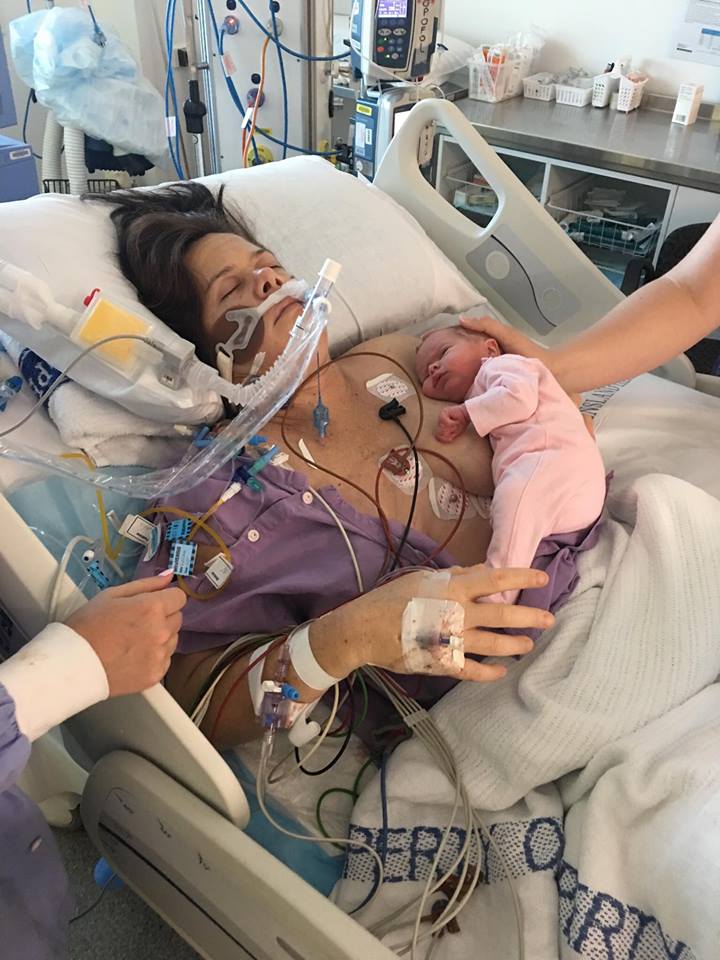Six months ago Jo Tronc’s heart stopped on the operating table at Mackay Base Hospital.
Just moments after giving birth to a healthy baby girl some of the amniotic fluid that surrounded her baby entered her blood stream, triggering a catastrophic reaction.
Jo’s body plunged into cardiac and respiratory failure as her heart struggled to pump enough blood and the invading fluid caused life-threatening problems with blood clotting.
It took almost four minutes of CPR to restore her heart rhythm and the mum of two remained in an induced coma for two days in Intensive Care before her condition became more stable.
Fortunately the anaesthetic, surgical and obstetric teams at the Base instantly suspected the rare and often fatal amniotic fluid embolism (AFE).
Jo has little or no memory of the moment she almost died.
“Soon after she was born I said to my husband Mitchell ‘are you going to get some photos of her?’.
“He turned around to answer me and tells me I said ‘my chest’. My eyes rolled back and the alarms sounded. My heart had stopped,” Jo said.
“The staff had to quickly take him out of the theatre while they started CPR.”

Little Adaline was born on 5 October 2016 by caesarean section after Jo started having contractions and bleeding due to placenta previa, a condition where the placenta is close to the cervix making a vaginal delivery too dangerous to risk.
“I had started bleeding and contracting and went to hospital around 10am. The obstetrician said we’ll do a caesar now because it’s best to do them during the day when there’s a lot of staff around and by 1.30pm Adaline was born.”
Seconds after delivery fluid surrounding Adaline in the womb leaked into Jo’s blood stream, essentially causing an allergic reaction that sent her into cardiac and respiratory arrest.
The theatre team worked on her for nearly four minutes before establishing a cardiac rhythm again.
Doctors have told Jo she’s lucky to have survived and that most cases are generally diagnosed on autopsy.
Jo says the kindness of staff at the Base will be with her for ever and one name she recalls readily is anaesthetist Dr Lincoln Gan Lim, who knew she was anxious about the epidural and whether she would feel the birth.
Lifesaving teamwork
For Dr Gan Lim this story is more than him having a good bedside manner – it’s about the teamwork he says undoubtedly saved Jo’s life.
In his 30 years as an anaesthetist he has seen two women with an AFE and Jo is the only one to survive. The first was when he was a junior doctor training in anaesthetics.
“Everything was fine, we were all OK, her husband was there, the baby came out and everyone was happy,” he recalled.
“It started as a pretty straight forward procedure, though we are always aware there might be some complications, and suddenly here you are. It’s the real thing happening.
“I knew I had to immediately intubate her, I said we have an emergency and I was just thinking we have to save her. I had a suspicion it might be an amniotic embolism as I’d seen one when I was a trainee doctor and had heard about one my colleague had at the old Base. I knew it has a high risk of death.
“There’s not time to think what is going on, no mucking around I just knew she needed an airway and that was my job.
Dr Gan Lim said Jo needed full CPR to be revived and she was moved to ICU.
“Jo is very lucky to be alive, she is one of the few good outcomes from AFE and I know a big reason for this is our team work and the fact our theatres and ICU are very well equipped.
“It’s very rare – we only have two to three minutes and if there had been a delay there could have been brain damage or death.
“There were many consultants, ICU was ready and waiting to accept her and it shows how good we are in a crisis,” Dr Gan Lim said.

Dr Ritu Rana who performed the caesarean section had recently moved to Mackay from the UK where she worked in obs and gynae for 13 years.
“This was my first experience with AFE however obstetricians are prepared for it, we know about it, we do drills about it so we are prepared for this emergency but it is one of our worst nightmares,” Dr Rana said.
“I was operating on Jo doing the caesarean section and she we had just delivered the baby when suddenly she collapsed, and we heard the anaesthetist call the emergency buzzer and heard the thuds on her chest doing CPR and we knew straight away she had an AFE.
“We completed her surgery as soon as we could and were thinking ahead because the next thing after an AFE is a massive haemorrhage and we were preparing our trays ready for a hysterectomy.
“However her resus was so efficient she was revived in minutes and didn’t get to this stage. She made an amazing recovery thanks to the teamwork of everyone involved,” Dr Rana said.

